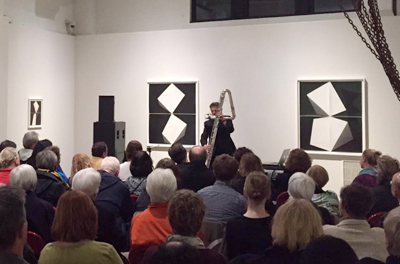by Jane Berkner

The smaller of Transformer Station’s two galleries was a great match for the intimacy of the instruments and the music played during this unusual concert. In contrast to the achromatic prints adorning the white walls, Ziegler performed his varied, vibrant and colorful music to a packed audience, painting an extraordinary opus of indefinable sounds that took us to visit numerous faraway places. It was exclusively Ziegler, at once classical, improvisatory, new age, jazzy, and world music.
Along with the regular C flute, he played an alto, bass and contrabass flute at different points in the evening. All of his instruments have been tinkered with and rebuilt to accommodate his unconventional playing style. In designing and reinventing his own instruments, he worked in conjunction with flutemakers from Holland and Japan. His alto flute was built in collaboration with Dutch flutemaker Eva Kingma. He used it for the first piece of the program, where it sounded like an aeolian harp. The piece itself, titled “Ave Kingma,” hinted of the Bach/Gounod “Ave Maria.”
Both his alto and contrabass flutes have been fitted with a membrane, a thin vibrating material that adds a forceful buzzing quality to the flute’s tone, creating a sound somewhat akin to a loud kazoo with additional high harmonics. Inside, the instruments are wired with small microphones that amplify and give duration to the percussive sounds introduced through key clicks and tongue thrusts.
Ziegler used a laptop as a mixing board, frequently working a line of foot pedals that were attached to it, to control the amplification or turn sound loops on and off. The loops acted as an ostinato in some pieces, or imitated percussion tracks in more jazz-oriented works. At one point, he set up a looped pattern of sustained flute and vocal notes on the bass flute, then laid it aside so that he could pick up the alto to play the melody.
With its electroacoustic amplification, the contrabass sounded remarkably like a bowed double bass. Ziegler told us that the sound of the contrabass reminds him of the gamba, which is what prompted him to arrange gamba music written by Renaissance composer Diego Ortiz. He performed “Recercada Primera,” a piece with a hauntingly beautiful melody that is simultaneously sung and played. Ziegler played the contrapuntal lines with care and personality, much like the charisma and character with which he imbues the variety of flute sounds that he makes.
Ziegler conjured up his travels with two of his pieces. He told us the story of his first trip to Iran, where he woke up at 6 am hearing an Iranian flute accompanied by drum. He rushed out and sleepily joined the music-making with his Western instrument, but it was not as loud as the local flutes, he said, and didn’t quite possess their flavor. He later modified his own flute, reenacting the scene in his “Ghashghai.” One can hear the exotic spices and bustling life that he witnessed early that morning. Later in the program he treated us to the sound of hammered strings in his “Maschad,” which mimics the dulcimer-like Persian santoor.
Ziegler has painstakingly worked out a way to reproduce a multitude of sounds that he hears in this world. That he can so clearly and cleverly recreate and recycle these sounds is a marvel, a gift to us all.
Published on ClevelandClassical.com March 23, 2015.
Click here for a printable copy of this article



